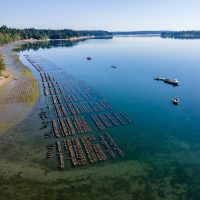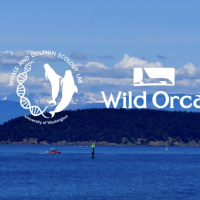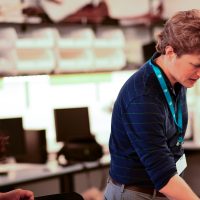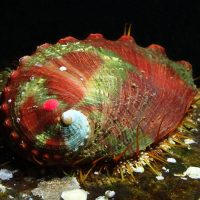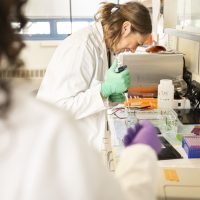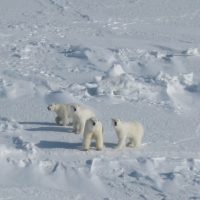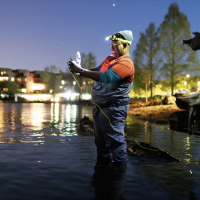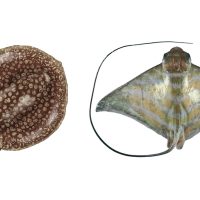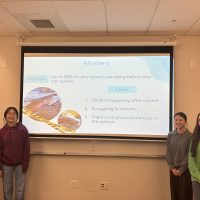Filter Results
In a shifting ocean environment, what are the impacts on Pacific oysters?
Seeking to understand the impacts of environmental stressors on Pacific oysters is the driving force behind a years-long research project involving scientists from the University of Washington and NOAA, and in collaboration with the oyster industry. Critical in aquaculture, Pacific oysters are the dominant oyster species grown on the US West Coast, with the industry in the Pacific Northwest alone valued at over $270 million a year.
Read moreWhy study diet? New research video featuring the southern resident killer whales
A new video features how genetic metabarcoding is being used by the UW Whale And Dolphin Ecology Lab, led by Amy Van Cise, to understand and conserve southern resident killer whales in the Salish Sea.
Read moreEvidence-based program helps students see themselves as scientists
Jose Guzmán wanted to help bridge the gaps that undergraduates faced in participating in research, and that graduate students faced in mentoring. And so, the IBIS program was born.
Read moreRaising the next generation of endangered pinto abalone
A new study, led by recently-graduated doctoral student Eileen Bates and principal investigator Jacqueline Padilla-Gamiño, and funded by Washington Sea Grant, found climate change stressors negatively impact pinto abalone during their larval stage.
Read moreGenetic metabarcoding to study marine mammals
Working with Assistant Professor Amy Van Cise in the Whale and Dolphin Ecology Lab, Arial Brewer (PhD, SAFS) and Mollie Ball (BS, Marine Biology) were preparing metabarcoding libraries to study marine mammals. This means barcoding DNA (or eDNA) in a manner that allows for the simultaneous identification of many taxa within the same sample.
Read moreA sweet surprise: Polar bear glucose reveals new insights into their reproduction and conservation
Each year, polar bears cycle through periods of intense feasting and prolonged fasting. For reproductive females, seasonal bulking is crucial – it fuels the winter denning and fasting period when they give birth. And when they emerge in spring, it gives biologists a chance to assess populations. A new study led by Sarah Teman explores whether A1c could reveal if a polar bear had recently denned, which – combined with the absence of cubs – may signal reproductive failure.
Read moreSeattle Times story features Ashley Townes’ work counting Chinook salmon in Lake Washington
Wearing a bright orange and gray dry suit, Ashley Townes stepped into the murky water of Lake Washington under a yellow moon, at a time when most others are asleep. A recent Seattle Times story features Ashley’s work as a fish biologist and a member of a grassroots group of neighbors who have advocated and fundraised for years to restore Be’er Sheva Park, to restore the shoreline and salmon habitat.
Read moreForce, form, and function: New method explains stingray skeleton architecture
A UW mechanical engineering student’s research is revealing how generative design can be used to analyze the complex shapes found in biological rigid structures like skeletons. John Michael Racy, along with co-authors including Adam Summers, turned to generative design to understand the complex forces that shape the elements of the stingray fin skeleton.
Read moreBuilding community among students
Building community among the different student groups at SAFS and Marine Biology—undergraduates, graduates and postdocs—the SAFS Undergrad Community Building Event was held was held for the fourth year running. Taking place on 13 May, undergraduates were invited to walk around and speak to grads and postdocs about different topics including grad school, what life looks like after graduation, and finding your way in science.
Read moreHigh schoolers design and teach a lesson on Pacific salmon and chemicals
What brought a group of high schoolers to SAFS to teach a lesson on Pacific salmon and chemicals? It all started with an interest in ecology in 9th grade biology class, and a quest to find a relevant, local topic that they could base a research project on. Since then, Iris Zhang, Ivy Wei and Sylvia Mei from Redmond High School worked with Amirah Casey to research the topic, and developed a SEAS lesson centered on the effects of 6PPD-quinone on salmon.
Read more